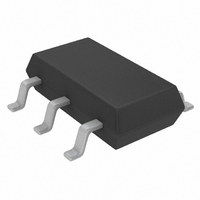LTC1772IS6#TRPBF Linear Technology, LTC1772IS6#TRPBF Datasheet - Page 5

LTC1772IS6#TRPBF
Manufacturer Part Number
LTC1772IS6#TRPBF
Description
IC CTRLR DC/DC S-DWN SOT23-6
Manufacturer
Linear Technology
Type
Step-Down (Buck)r
Datasheet
1.LTC1772ES6TRMPBF.pdf
(12 pages)
Specifications of LTC1772IS6#TRPBF
Internal Switch(s)
No
Synchronous Rectifier
No
Number Of Outputs
1
Voltage - Output
0.8 ~ 9.8 V
Current - Output
1A
Frequency - Switching
550kHz
Voltage - Input
2.5 ~ 9.8 V
Operating Temperature
-40°C ~ 85°C
Mounting Type
Surface Mount
Package / Case
TSOT-23-6, TSOT-6
Lead Free Status / RoHS Status
Lead free / RoHS Compliant
Power - Output
-
Available stocks
Company
Part Number
Manufacturer
Quantity
Price
OPERATIO
Main Control Loop
The LTC1772 is a constant frequency current mode switch-
ing regulator. During normal operation, the external
P-channel power MOSFET is turned on each cycle when
the oscillator sets the RS latch (RS1) and turned off when
the current comparator (ICMP) resets the latch. The peak
inductor current at which ICMP resets the RS latch is
controlled by the voltage on the I
output of the error amplifier EAMP. An external resistive
divider connected between V
EAMP to receive an output feedback voltage V
load current increases, it causes a slight decrease in V
relative to the 0.8V reference, which in turn causes the
I
current matches the new load current.
The main control loop is shut down by pulling the I
pin low. Releasing I
current source to charge up the external compensation
network. When the I
control loop is enabled with the I
pulled up to its zero current level of approximately 0.7V.
As the external compensation network continues to charge
up, the corresponding output current trip level follows,
allowing normal operation.
Comparator OVP guards against transient overshoots
> 7.5% by turning off the external P-channel power
MOSFET and keeping it off until the fault is removed.
Burst Mode Operation
The LTC1772 enters Burst Mode operation at low load
currents. In this mode, the peak current of the inductor is
set as if V
the voltage at the I
inductor’s average current is greater than the load require-
ment, the voltage at the I
I
high, turning off the external MOSFET. The sleep signal
goes low when the I
and the LTC1772 resumes normal operation. The next
TH
TH
/RUN voltage to increase until the average inductor
/RUN voltage goes below 0.85V, the sleep signal goes
ITH
/RUN = 1V (at low duty cycles) even though
U
TH
TH
TH
/RUN pin is at a lower value. If the
TH
(Refer to Functional Diagram)
/RUN pin reaches 0.35V, the main
/RUN voltage goes above 0.925V
/RUN allows an internal 0.5µA
TH
/RUN pin will drop. When the
OUT
TH
and ground allows the
/RUN pin, which is the
TH
/RUN voltage then
FB
. When the
TH
/RUN
FB
oscillator cycle will turn the external MOSFET on and the
switching cycle repeats.
Dropout Operation
When the input supply voltage decreases towards the
output voltage, the rate of change of inductor current
during the ON cycle decreases. This reduction means that
the external P-channel MOSFET will remain on for more
than one oscillator cycle since the inductor current has not
ramped up to the threshold set by EAMP. Further reduc-
tion in input supply voltage will eventually cause the
P-channel MOSFET to be turned on 100%, i.e., DC. The
output voltage will then be determined by the input voltage
minus the voltage drop across the MOSFET, the sense
resistor and the inductor.
Undervoltage Lockout
To prevent operation of the P-channel MOSFET below safe
input voltage levels, an undervoltage lockout is incorpo-
rated into the LTC1772. When the input supply voltage
drops below approximately 2.0V, the P-channel MOSFET
and all circuitry is turned off except the undervoltage block,
which draws only several microamperes.
Short-Circuit Protection
When the output is shorted to ground, the frequency of the
oscillator will be reduced to about 120kHz. This lower
frequency allows the inductor current to safely discharge,
thereby preventing current runaway. The oscillator’s fre-
quency will gradually increase to its designed rate when
the feedback voltage again approaches 0.8V.
Overvoltage Protection
As a further protection, the overvoltage comparator in the
LTC1772 will turn the external MOSFET off when the
feedback voltage has risen 7.5% above the reference
voltage of 0.8V. This comparator has a typical hysteresis
of 20mV.
LTC1772
1772fb
5














